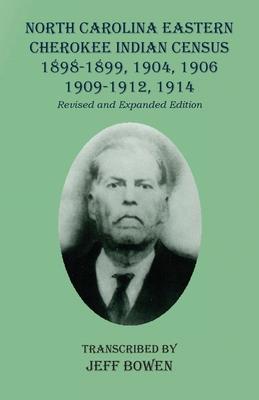The census records themselves concern the Eastern Band of Cherokee Indians from Cherokee, North Carolina, living on the reservation known as the Qualla Boundary, and were enumerated by various Indian Agents in the employ of the U.S. Department of the Interior. Individuals enumerated in the successive censuses are descendants of the Cherokees who were not removed to Indian Territory during the period 1838-1839 in the migration known as the Trail of Tears. Mr. Bowen has transcribed each census in chronological order, and thereunder by household membership. While there is sometimes additional data, information provided in the census almost invariably gives the individual's name, family relationship, age, and sex--information that is critical in any genealogical research. The complete name index at the back of the volume refers to about 9,000 Eastern Cherokee who lived on the Qualla Boundary between 1898 and 1914. Finally, persons or institutions who purchased the first edition of this book or the author's two sequel series devoted to Qualla Boundary inhabitants (Eastern Cherokee Census, Cherokee, North Carolina, 1915-1922 and Eastern Cherokee Census, Cherokee, North Carolina, 1923-1929) should consider adding this reference to their collection.

Book
North Carolina Eastern Cherokee Indian Census 1898-1899, 1904, 1906, 1909-1912, 1914: Revised and Expanded Edition
(Write a Review)
Paperback
$44.00
The census records themselves concern the Eastern Band of Cherokee Indians from Cherokee, North Carolina, living on the reservation known as the Qualla Boundary, and were enumerated by various Indian Agents in the employ of the U.S. Department of the Interior. Individuals enumerated in the successive censuses are descendants of the Cherokees who were not removed to Indian Territory during the period 1838-1839 in the migration known as the Trail of Tears. Mr. Bowen has transcribed each census in chronological order, and thereunder by household membership. While there is sometimes additional data, information provided in the census almost invariably gives the individual's name, family relationship, age, and sex--information that is critical in any genealogical research. The complete name index at the back of the volume refers to about 9,000 Eastern Cherokee who lived on the Qualla Boundary between 1898 and 1914. Finally, persons or institutions who purchased the first edition of this book or the author's two sequel series devoted to Qualla Boundary inhabitants (Eastern Cherokee Census, Cherokee, North Carolina, 1915-1922 and Eastern Cherokee Census, Cherokee, North Carolina, 1923-1929) should consider adding this reference to their collection.
The census records themselves concern the Eastern Band of Cherokee Indians from Cherokee, North Carolina, living on the reservation known as the Qualla Boundary, and were enumerated by various Indian Agents in the employ of the U.S. Department of the Interior. Individuals enumerated in the successive censuses are descendants of the Cherokees who were not removed to Indian Territory during the period 1838-1839 in the migration known as the Trail of Tears. Mr. Bowen has transcribed each census in chronological order, and thereunder by household membership. While there is sometimes additional data, information provided in the census almost invariably gives the individual's name, family relationship, age, and sex--information that is critical in any genealogical research. The complete name index at the back of the volume refers to about 9,000 Eastern Cherokee who lived on the Qualla Boundary between 1898 and 1914. Finally, persons or institutions who purchased the first edition of this book or the author's two sequel series devoted to Qualla Boundary inhabitants (Eastern Cherokee Census, Cherokee, North Carolina, 1915-1922 and Eastern Cherokee Census, Cherokee, North Carolina, 1923-1929) should consider adding this reference to their collection.
Paperback
$44.00